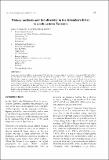| dc.description.abstract | Assessment of common fishery methods and of fish diversity was undertaken In two fishing camps on the Kilombero River in south-eastern Tanzania in surveys towards the end of the dry season. 1994. Fishermen identified 23 different types of fish that they caught on a regular basis. Only 19 species at' fish, belonging to 17 genera and I I farnilies were, however, identified according to Linncan taxonomy. Hooks, nets, traps and spears were used to catch fish. Fish were either sold fresh, or preserved for storage and long-distance transport by smoking or frying. Based on frequency distributions of the
numbers of fish landed over a 4 day period at one of the camps, a Shannon-diversity index of 1.95 was calculated. The fork (or total) length of 480 fish and the weight of 413 fish were measured and length frequency distributions a" well as length-weight relationships determined for the six most common species. It is concluded that local fishing methods applied in the Kilombero River allow for sustainable fish production. | en_US |

